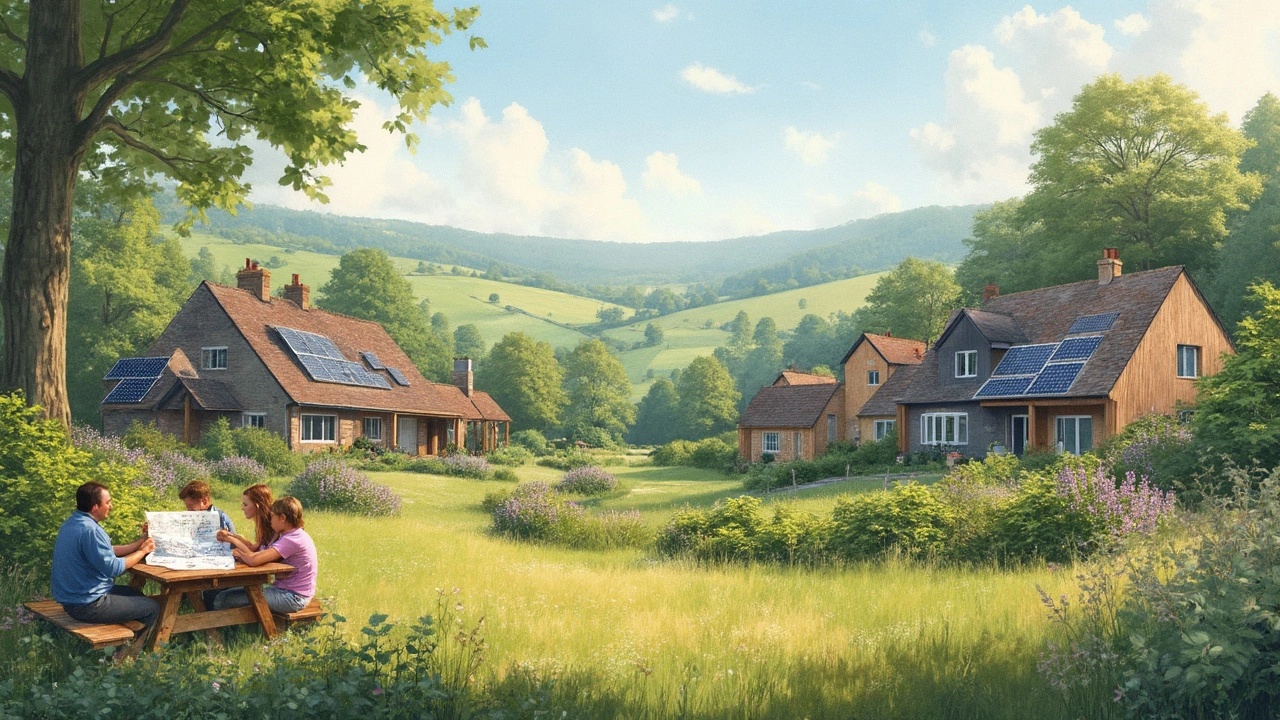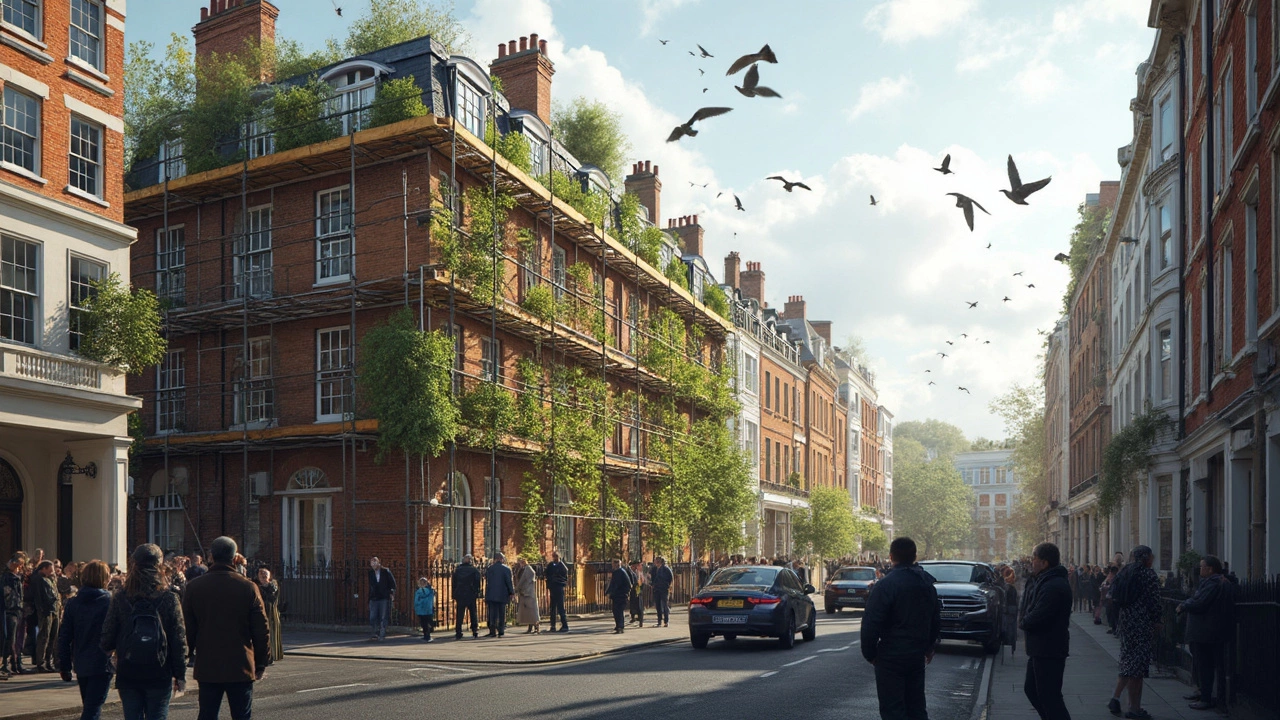Disadvantages of Eco Homes: What You Need to Know
 Mar, 24 2025
Mar, 24 2025
So, you're thinking about going green and investing in an eco home. It's an exciting step towards sustainable living, but before you jump in, there are some hiccups worth considering. First off, these environmentally-friendly homes often come with a hefty price tag. The initial costs can be high due to specialized building materials and technology.
Another thing to keep in mind is maintenance. Eco homes may require specific know-how and constant attention to ensure everything's running smoothly. Not to mention, if you're hoping for a chic modern design, the choices can be somewhat limited due to eco-friendly constraints.
Location is another hurdle. Eco homes are often best suited to specific environments, and your desired plot may not align with these requirements. Additionally, embracing this green lifestyle could mean some financial and lifestyle adjustments - are you ready for that commitment?
- High Initial Costs
- Maintenance Challenges
- Limited Design Choices
- Location Restrictions
- Skill and Knowledge Requirements
- Financial and Lifestyle Adjustments
High Initial Costs
Jumping into the world of eco homes can burn a hole in your wallet at first. It's no secret that going green often means spending some green. Why? Well, the fancy technology and materials that make these homes sustainable don't come cheap. You might wonder, is it really worth it?
One significant factor is the cost of specialized construction materials. Building an eco-friendly cottage often requires materials like recycled steel, sustainably harvested wood, or high-performance windows. These are pricier than standard options but crucial for minimizing your home's ecological footprint.
Why the Expense?
Besides materials, think about the advanced technology involved. Many eco homes come equipped with solar panels, geothermal heating, or rainwater harvesting systems. These upgrades enhance energy efficiency but require hefty initial investments. According to a report, solar panels alone can range between $15,000 and $25,000 depending on the house size and energy needs.
Beyond the Price Tag
Paying more upfront may seem daunting, but don't forget the long-term savings. While the initial sticker shock might catch you off guard, these homes can drastically cut your utility bills in the long run. Imagine slashing your energy costs by 30-40%!
It's also worth noting that some governments provide incentives for building green. Tax credits or rebates can significantly offset the costs, taking the sting out of that initial investment.
Maintenance Challenges
Living in an eco home can feel like a dream come true—until the maintenance reality sets in. One of the key challenges is dealing with the unique materials and systems that make these homes so sustainable. Many eco-friendly cottages incorporate solar panels, green roofs, and specialized water systems, each requiring unique care.
Solar Panel Upkeep
Solar panels, a staple in sustainable living, generally have low maintenance needs but still require periodic cleaning and checks to ensure they’re functioning at peak efficiency. Dust, leaves, and other debris can decrease energy output, so regular cleaning is a must. It’s also important to have occasional professional inspections to avoid costly repairs.
The Green Roof Dilemma
Green roofs are not only beautiful but help insulate and maintain temperature. But they need green thumbs and attention. You'll have to consider regular weeding, watering during dry spells, and ensuring that the roof structure itself remains sound.
- Weeding: Keep those plants in check to prevent unwanted growth.
- Watering: Irrigation systems or manual watering is necessary during drier months.
- Structural Inspections: Check periodically to prevent water damage or leaks.
Specialized Water Systems
Eco homes often use rainwater collection systems and greywater recycling to minimize water waste. While efficient, these systems require a thorough understanding and consistent maintenance to prevent clogs and leaks. Regular checks are essential to ensure they aren’t harboring bacteria or leading to water quality issues.
All these maintenance tasks add up in eco-friendly cottages, sometimes requiring more technical skills than a traditional home. You might find yourself becoming best buddies with a local eco-specialist or investing in professional help to keep everything running smoothly. It's a commitment, but for many, the payoff is worth it.
Limited Design Choices
When it comes to eco homes, one of the big catches is that you're working with a tighter design framework. Think of it like this: eco-friendly construction is ruled by a set of guidelines that prioritize energy efficiency and sustainability over aesthetics. This can affect everything from the shape of the house to the materials used.
Most eco homes, for instance, have a very minimalist look. While this might rock some people's boats, others might find it a bit stark. It's not just about appearance, either. Materials like reclaimed wood, bamboo, or rammed earth might be key in building eco-friendly cottages, but they can limit your design options.
Sticking to Basics
Eco designs often embrace open plans and multi-functional spaces, which is awesome for energy flow but might not suit everyone's taste for coziness. Traditional room divisions might be tossed out in favor of maximizing natural light or reducing heating needs.
- Limited color choices due to the nature of eco-friendly paints and finishes.
- Low-impact building methods are more rigid, making custom designs pricier and harder.
- Focus on shapes that optimize sun exposure, which can restrict certain architectural styles.
Now, one more thing you might not know is that achieving that highly efficient design sometimes means compromising on square footage. Smaller living areas are easier to heat and cool, but they might feel cramped if you’re used to a more spacious environment.
So, if you’re eyeing that grand, spread-out mansion vibe, a sustainable living design might call for some serious adjustments. Balancing your dream home style with the practical needs of green building can be a bit of a juggling act.

Location Restrictions
Thinking about building an eco home? One of the first things you'll realize is that not every plot of land will be a perfect fit. Eco homes tend to thrive in locations that support sustainable practices, so the land's geography, climate, and access to resources all play a big role in choosing a site.
Geography Matters: Steep terrains, flood plains, or overly shaded areas can pose significant challenges. These factors can interfere with essential features like rainwater collection or solar panel efficiency. For instance, a site that's too shaded by neighboring buildings or trees might limit your solar energy options.
Climate Considerations: The local climate can also make or break the eco-friendly nature of your home. Areas with extreme temperatures might require more resources for heating and cooling, defeating some energy savings. Coastal regions might have variable weather conditions that impact the durability of eco-friendly materials over time.
Resource Access: Proximity to resources like water and sustainable building materials is another crucial factor. Building an eco home far from these resources can increase costs and environmental impact due to transportation needs.
Before You Buy
If you're serious about this sustainable dream, here are a few steps you might want to consider:
- Research local zoning laws and building codes since some regions have strict guidelines about sustainable structures.
- Consult with an expert who specializes in eco-friendly designs to evaluate potential sites.
- Assess potential energy sources beforehand – can your chosen site support sustainable living?
Considering these location-based restrictions can save you a lot of headaches down the road. It ensures your new eco home is not only green but also practical and efficient in its setting.
Skill and Knowledge Requirements
Living in an eco home isn't just about making a bold environmental statement—it's about understanding the intricacies of your home's systems and the knowledge to keep them humming along smoothly. It's not just plug-and-play; these homes can demand a good bit of know-how.
Take, for instance, the technology behind your heating and cooling systems. Many eco homes operate on geothermal or solar energy. If phrases like 'heat pumps' and 'photovoltaic panels' make your eyes glaze over, it might be worth brushing up on these essential components. Learning the basics of how they function can save a lot of headaches down the road.
Understanding Sustainable Materials
Choosing to live sustainably means getting cozy with a variety of eco-friendly materials. From recycled steel to bamboo, these materials behave differently compared to traditional options. They may require special treatments or specific cleaning methods. Don't worry, you don't need to become an expert overnight, but some familiarity can be really helpful.
Maintenance and Troubleshooting
As with any home, things can and will go wrong. Knowing how to tackle common issues is crucial. Eco-savvy residents might need to tackle rainwater collection maintenance or optimize a greywater recycling system. Not your typical homeowner tasks, but they're par for the course in an eco home.
Here's a little glimpse into what might be on your to-learn list:
- Efficiently managing energy consumption and reducing waste
- Maintaining and troubleshooting tech systems like smart thermostats
- Choosing plants and landscaping for the best ecological impact
It might sound a bit much at first, but once you get the hang of it, being an eco-homeowner can be incredibly rewarding. Plus, there's a growing community of folks who are more than willing to swap tips and tricks.
Financial and Lifestyle Adjustments
Going green with an eco home isn't just about the house itself; it's a shift in both finances and lifestyle. The initial investment can be daunting, but let's talk long-term. While you might spend more upfront, you're likely to save on energy bills over time. Those solar panels and efficient appliances do pay off eventually.
Here's the catch, though: some costs might sneak up on you. Certain sustainable materials or tech could need replacing more often than traditional ones. It's worth researching the lifespan and maintenance needs of these components.
Now onto lifestyle changes. Living in an eco home often means embracing habits like reducing water consumption and perhaps even composting. It's not just about adjusting your budget; it's about tweaking your daily routines to fit this sustainable approach. But hey, that could mean learning to love the little things, like line-drying clothes or planting a vegetable garden.
Then, there’s the potential resale factor. While the eco homes market is growing, not everyone is ready to buy green. It might take a bit longer to sell or require educating potential buyers on the benefits.
So, are you ready for these adjustments? A little planning, a bit of research, and a willingness to adapt could go a long way in making the most of your eco-friendly lifestyle.